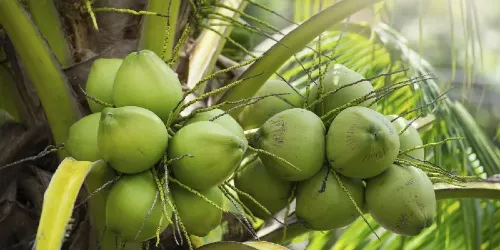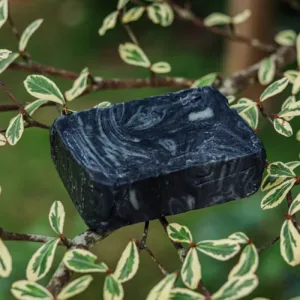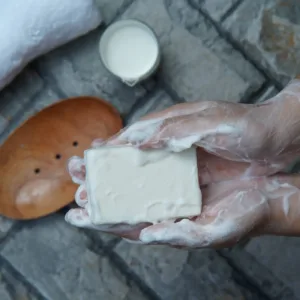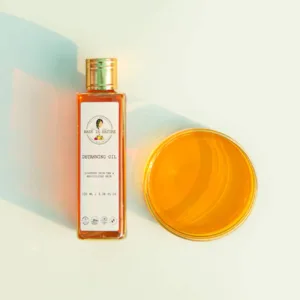
Coconut
Synonyms: coconut palm
Scientific Name: Cocos nucifera L.
Family: Arecaceae (palm trees)
Habitat
India, South-East Asia.
Constituents
Coconut meat: 35% fat, trace elements such as potassium, phosphorus, copper, iron, zinc and selenium. Coconut oil: primarily saturated fatty acids, of which approximately 50% lauric acid.
Description
It is impossible to imagine tropical beach coastlines without their coconut trees. Towering at a height of up to 98 feet/30 meters, the tree tops are dominated by a spherical crest of 30 to 40 impressive palm leaves, measuring up to 6 feet/five meters long and weighing 22-33 lbs./10 to 15 kilograms. The narrow segments of each individual palm leaf are flexibly connected to the base of the leaf blade. This enables the thirsty coconut tree to overlap the segments and prevent too much water from evaporating from its leaves. The palm fronds grow in a spiral format, usually progressing clockwise from the highest point of the trunk. In the first year, they point upwards, in the second year horizontally and in the third year, they hang down, ready to fall from the tree leaving leaf scars on the trunk.
The structural pliability of the palm fronds has invaluable benefits when subjected to the strong, tropical winds. The trunk is also designed for flexibility. The thick base and the outer area are far more stable than the top and the inside of the trunk. Coconut trees are firmly anchored in the ground with roots that grow both sideways and downwards to groundwater. Coupled with their trunks’ pliability, this enables them to even withstand tsunamis.
At five to seven years old, coconut trees start to blossom. All year round, flowers grow from the axils – yellow branches with up to 40 female flowers at the base and over 10,000 male flowers extending out to the tip. The male flowers open up about two weeks before the female ones to prevent self-pollination. The pollen is spread by the wind and various insects. Once the female flowers have been pollinated, coconuts grow. Their various development stages can be seen side by side with the flowers, as is typical in the tropics: we rarely find tropical trees that flower and bear fruit in different seasons; everything seems to happen at once.
Incidentally, from a botanical perspective, the coconut is not actually a nut; it is a drupe, like the almond. The seeds with their endosperm (the edible, white coconut meat with brown skin) are surrounded by a woody outer casing, the brown coconut shell, from which many varied items are made. Once the fibrous, non-edible fruit meat and the hard fruit shell have been removed, the kernel is sold in shops. It takes about a year for a coconut to ripen fully. During this period, an extraordinary change takes place inside the coconut: the initially plentiful coconut water seems to disappear. In its place, a soft, thin, gelatinous layer develops into thick, solid coconut meat.
Despite weighing a fair amount, coconuts can still float and therefore be spread by water. This is because the fibrous meat, which traps air, and the watertight hollow in the kernel make them buoyant. Upon falling into the sea, the coconuts float to new shores where they become beached and germinate. The seedling grows out of one of the three seedling pores in the kernel. Anyone wanting to get to the coconut water should bore out the kernel from this active germination pore.
Uses
Young palm shoots, palm hearts (the growing inner core of the palm trees), the white coconut meat and the coconut water are all popular foods. In the countries of origin, street stalls offering unripe, green coconuts ready to drink are an everyday sight. While still green, the six to seven-month-old coconuts can be opened with a machete to get to the sweet, almost clear coconut water. This is sterile, nearly fat free and has the same isotonic value as blood. In emergencies, coconut water has, therefore, traditionally been used as an infusion solution.
An important ingredient in Asian cooking, coconut milk should not be confused with coconut water. This is the juice pressed from the mixture of freshly grated coconut meat and water. Cream of coconut is, in turn, a mixture of coconut milk and coconut oil.
Yet there is also another liquid that can be obtained from coconut trees: palm nectar. This is rich in vitamin B and is mainly extracted from the inflorescence. It can be fermented to produce palm wine, concentrated to produce palm honey or palm sugar or distilled with rice mash to produce arrak. Palm wine can, in turn, be fermented to produce palm vinegar.
Dried coconut meat, known as ‘copra’, can be used to produce grated coconut or coconut oil. As the latter solidifies even at room temperature, it is often referred to as coconut fat or coconut butter. It can be used as cooking or frying oil and is suitable for heating to high temperatures.
However, coconut fat is not only used for cooking but also in soaps, pharmaceutical products and cosmetics. It stabilizes the components of a formulation and makes the skin silky smooth. When penetrating the layers of the skin, coconut oil does so slowly, leaving it feeling baby soft. This also makes it a good massage oil. Coconut oil also has good antioxidant properties.
In Africa and South-East Asia, coconut oil is traditionally used for skin wounds.
The non-edible components of coconuts can also be used in many different ways. For example, the fibrous meat of mature coconuts can be used as a mattress filler, the fibers of green coconuts to make ropes, the trunks to construct homes, the palm fronds to build roofs and woven baskets and the shell as firewood, for buttons, household articles, and musical instruments or to produce fuel.
Interesting Facts
The scientific name ‘Cocos’ comes from the Spanish word ‘coco’, meaning skull or head and accurately describing the coconut. The word ‘Nucifera’ is derived from the Latin ‘nux’ = ‘nut’ and ‘ferre’ = ‘to carry’, therefore meaning nut-carrying.
Coconut oil should not be confused with palm oil. The latter is obtained from oil palms (Elaeis guineensis), which are grown on large plantations created by clearing huge areas of rainforest. In contrast, coconut tree plantations are usually small and offer growers a good livelihood due to the plants’ versatile uses. For example, the fallen leaves and shells from 35 palm trees can supply a family of five in India with fuel for a year. On mixed crop plantations, the large trees provide shade for the other plants.
As the ripe coconuts do not always fall to the ground of their own accord, pickers climb the trees in the plantations. In Thailand and Malaysia, macaque monkeys have been trained to collect the ripe coconuts from the trees.
At the end of the 19th century, Dr. Heinrich Schlinck (1840–1909), the owner of a refinery for technical plant oils, developed a procedure for obtaining coconut fat, which he launched on the market in 1887 under the name ‘Mannheim coconut butter’. The German Agrarian League saw coconut fat as a serious competitor to their butter and protested against the product name. Although this did not stop Schlinck from selling his product, from 1892 he did so under the protected brand name ‘Palmin’ (derived from ‘palm’). Sales of the new fat soared. At the end of the 19th century, almost all fats on the market were animal fats, which were becoming harder to get hold of and more expensive due to rapid population growth. As a lower cost product, Palmin filled the gap in supply. Furthermore, coconut fat actually has nutritional benefits over butter. Although it is based on saturated fatty acids, these are mainly medium-chain acids such as lauric acid, which our digestive system can optimally use. Lauric acid is one of the components found in breast milk.
In the Philippines, there are many legends involving the coconut tree, such as the following creation myth: in ancient times, when the Earth was still desolate and empty, three gods ruled the universe without knowing of the others’ existence. The god Bathala lived on the Earth and the serpent god Ulilang in the clouds. The winged god Galang, on the other hand, travelled from place to place. When Bathala and Ulilang met for the first time, such a great power struggle ensued between them after three days that they saw a dual as the only resolution. Bathala killed the serpent god, burned his remains and buried his ashes. In complete contrast, when Bathala met Galang, such a great friendship was formed that they lived together happily for many years. When Galang became ill and realised that he was going to die, he asked his friend to bury his body in the same place as he had buried the serpent god’s ashes. Bathala looked on with astonishment as out of the shared grave there rose a huge tree with long leaves and spherical fruits: a coconut tree. He saw in it elements of both of the gods: the trunk took on the shape of the serpent god Ulilang while the feathery palm fronds reminded him of his friend Galang’s wings and the coconuts of his face. Bathala took this as a sign and finally began to create life on Earth. He started with plants and trees before finally creating humans, who could look after the coconut tree. Bathala used the trunk and the palm fronds to build the first house, while the coconuts provided food for the people.
Another story from the Philippines is as follows: the Sultan’s daughter Putri was so beautiful that she was surrounded by an endless stream of admirers. Her father insisted that she marry one of them. However, as is the case in fairytales, Putri fell in love with Wata-Mama, the palace gardener, who also loved her in return. Conveniently, Wata-Mama turned out to be a prince whose parents had been killed. But the young lovebirds’ happiness was not to last for long as a jealous rival killed and beheaded the prince. In the place where Wata-Mama’s head was buried, a coconut tree appeared. It grew all the way up to grieving Putri’s window and looked in with its coconuts.
Incidentally, walking around under coconut trees is not exactly safe. Every year, 150 people around the world are killed by coconuts. Among the reasons that they fall are palm thieves (Birgus latro). With a body length of up to 16/40 cm and a leg span width of up to a meter (3.3 feet), the palm thief is the world’s largest land-dwelling crab. Also known as coconut crabs, these hermit crabs climb coconut trees in search of food and use their powerful claws to crack the coconut shells to get to the meat inside. This sometimes causes entire fruits to fall.
The Plant in our Products
Bask in Nature’s products containing Ingredients from Coconut Tree :








